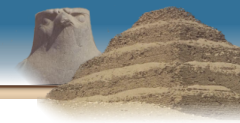Dashur and Cairo
Having firmly established that I'm a wimp of the first order, we pack up and leave the lovely "camp", headed for the airport at Sharm. A short flight later, we arrive in Cairo again. We immediately head across the Nile to Dashur , one of the pyramid sites south of Giza. These are lined up a row, from Meidum to Dashur to Saqqara to Giza. Dashur is home to two lovely pyramids, but is infrequently visited. It has only been open to the public for the last few years, as it was previously on the site of a military base. Even now, the fence indicating the edge of the base is perhaps 100 feet from the pyramids. The road from the village has checkpoints before the pyramids, and there are guard towers along the fence ensuring that the tourists remain firmly in the right location. Given the length of the drive and the somewhat unwelcoming situation, most tourists don't venture this far. It's too bad, actually, because it's nice to see pyramids that aren't surrounded by touts and guides and hordes.
The Bent pyramid of Dashur is the first smooth-sided pyramid, chronologically between the Step pyramid of Saqqara and the Great pyramid of Giza. It was on the Bent pyramid that the architects of Egypt learned the optimal angle for stability. The first part of the pyramid is built at an angle of 54 degrees, then halfway up it changes to the shallower 43 degree angle used thereafter. Clearly the early construction was too steep and unstable. Despite the odd shift, this pyramid is well-preserved. The blocks used here are of moderate size, between the small, brick-like size of Saqqara and the mammoth blocks of Giza.
Nearby is the Red pyramid, the earliest "true" pyramid. It is built of local red stone, and has a distinctly different color. The interior chambers are open to visitors, and echo the contruction of the Great pyramid at Giza. However, due to the low volume of visitors, it is much easier to gain access and to really look at the chambers, despite the intense heat. As we climb inside, we hear a series of muffled booms. Visions of falling stones and being trapped go through my head, until I realize it's just the echo of artillery fire from the range next door. Better?
After this brief visit back to the Old Kingdom, it's time to return to the (relative) current day, to Old Cairo. This section of town dates back to the Romans, and features many small early Christian churches, a few synagogues, and a warren of tiny houses in the Coptic quarter. There is a Coptic museum, closed when we were there, which is supposed to be quite good. The most impressive sight to me was the Ben-Ezra synagogue, built on the site of an early church and now restored by local historians, mostly Islamic. During reconstruction work about a century ago, a large collection of early Hebrew documents was found that has provided a great deal of insight into this early Jewish community. Several of the churches are part of the legend of Mary and Jesus, who traveled through Egypt during Jesus' childhood. Unfortunately, as the water table of Egypt rises, many of these buildings are now flooding. It's a unique place, one deserving of more restoration.
We retire to a modern hotel on the Nile, closer to the center of town. CNN tells us that the Red Sox are out of the race for the World Series (sigh), and that Ahnold is really, no kidding, governor. Sure, why not? Somewhat against my advice, after dinner we go to the Son et Lumiere show at Giza. This was featured in a Roger Moore Bond film, which I recommend you see if you want to capture the full, cheesy experience. The best way to view the Son et Lumiere is from the bar in the back, where you can laugh without offending anyone. It's a 45 minute experience of loud booming noises, an insipid and self-important voiceover, with colored lights and laser pictures painting the Sphinx and the pyramids. It's actually a tad embarrassing, considering how long these monuments have stood quietly in the desert. Many tourists love the show, and constantly try to take pictures of the colored lights on the pyramids, despite the absolute impossiblity of them showing up on normal film. Many forget to turn off the automatic flash feature of their cameras, adding to the epileptic seizure possiblity of the whole experience. Some very funny Aussies sit behind us and at one point get a great shot of Steve's head. They laughingly show it to us before giving up on photography in favor of beer drinking. Excellent. The only way to get through the horrible quality of the voiceover is through mockery. Steve and I move into full MST mode, but sometimes the script itself is impossible to improve. The pyramids are, apparently, the trimuph of the line over all other geometric forms. Discuss.
Son et Lumiere has become a company in and of itself, and they produce shows at all the sites of Egypt -- Luxor, Karnak, even now Abu Simbel (viewed from a boat, I hear). The shows are in multiple languages, and they generally run three a night at Giza. It's the sort of thing one probably must do for the full Egypt experience, but I really do hate the darn things. I also have enormous sympathy for whoever lives in the apartment buildings right at the foot of the Sphinx. Can you imagine?




